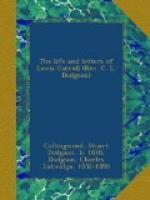He spent a part of the Long Vacation at Freshwater, taking great interest in the children who, for him, were the chief attraction of the seaside.
Every morning four little children dressed in yellow go by from the front down to the beach: they go by in a state of great excitement, brandishing wooden spades, and making strange noises; from that moment they disappear entirely—they are never to be seen on the beach. The only theory I can form is, that they all tumble into a hole somewhere, and continue excavating therein during the day: however that may be, I have once or twice come across them returning at night, in exactly the same state of excitement, and seemingly in quite as great a hurry to get home as they were before to get out. The evening noises they make sound to me very much like the morning noises, but I suppose they are different to them, and contain an account of the day’s achievements.
His enthusiasm for photography, and his keen appreciation of the beautiful, made him prefer the society of artists to that of any other class of people. He knew the Rossettis intimately, and his Diary shows him to have been acquainted with Millais, Holman Hunt, Sant, Westmacott, Val Prinsep, Watts, and a host of others. Arthur Hughes painted a charming picture to his order ("The Lady with the Lilacs”) which used to hang in his rooms at Christ Church. The Andersons were great friends of his, Mrs. Anderson being one of his favourite child-painters. Those who have visited him at Oxford will remember a beautiful girl’s head, painted by her from a rough sketch she had once made in a railway carriage of a child who happened to be sitting opposite her.
[Illustration: J. Sant. From a photograph by Lewis Carroll.]




